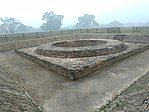Cooch Behar district (pronounced [ˈkuːtʃ biˈɦaːr]) is a district of the Indian state of West Bengal. Formerly part of the Kamarupa kingdom, the area became the heart of the Kamata Kingdom in the 12th century. During the British Raj, the district was known as Cooch Behar state ruled by the Koch dynasty until 1949, when it became part of India. The district consists of the flat plains of North Bengal and has several rivers: the most notable being the Teesta, Jaldhaka and Torsa. The district has the highest proportion of Scheduled Castes in the country, where they form a majority.[3]
- ^ a b "Fact and Figures". Wb.gov.in. Retrieved 5 July 2019.
- ^ "52nd Report of the Commissioner for Linguistic Minorities in India" (PDF). Nclm.nic.in. Ministry of Minority Affairs. p. 85. Archived from the original (PDF) on 25 May 2017. Retrieved 5 July 2019.
- ^ Cite error: The named reference
SCwas invoked but never defined (see the help page).





